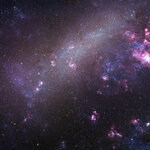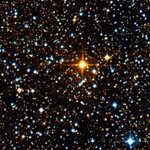Space

Most people don't realize it, but the majority of stars in our galaxy arrive in pairs. These fraternal twins tend to be somewhat equal partners when it comes to mass, but in a quest to find mismatched star pairs called extreme mass-ratio binaries, astronomers have discovered a new class of binary stars: One star is fully formed while the other is still in its infancy.
It wasn't easy. The more massive a star is, the brighter it shines. This makes it difficult to identify extreme mass-ratio binaries because the heavier star outshines, and thereby hides, the lighter star. To circumvent that,…

The Planck collaboration has released data from four years of observation by the European Space Agency (ESA)'s Planck spacecraft. The aim of the Planck mission is to study the Cosmic Microwave Background, the light left over from the Big Bang.
The measurements, taken in nine frequency bands, were used to map not only the temperature of the radiation but also its polarization - a property of light like color or direction of propagation - which provides additional information about the very early Universe, around 380,000 years old, and our Galaxy's magnetic field.
From 2009 to 2013, ESA'…
Yesterday, phys.org posted a story titled, “No Big Bang? Quantum equation predicts universe has no beginning.” Coauthors Ahmed Farag Ali and Saurya Das, “have shown in a paper published in Physics Letters B that the Big Bang singularity can be resolved by their new model in which the universe has no beginning and no end.” (Read the full article
here.)
On the other hand, Alexander Vilenkin says the universe probably did have a beginning:
"Big Bang Expansion" image source: phys.org
Original arXiv paper “Cosmology from quantum potential” by Ahmed Farag Ali and Saurya Das.
Follow me on…

Some people believe we are in a new Enlightenment, with science making food plentiful and likely to make energy cheap enough to be unnoticeable in the next few decades as well. We share one other thing in common with the 18th century - solar activity.
Scientists have been counting sunspots
with small telescopes
since 1610 so it was quickly learned that the Sun’s activity increases every eleven years, according to the interval in the growth of the number of darker and colder spots in comparison with the rest of its surface. The more spots that appear, the more luminous the surrounding areas…

Spot the biggest star. Rutherford Observatory
By Jillian Scudder, Postdoctoral Research Fellow in Astrophysics at University of Sussex
The universe is such a big place that it is easy to get baffled by the measurements that astronomers make. The size of UY Scuti, possibly one of the largest stars we have observed to date, is certainly baffling.
Not surprisingly, UY Scuti is classified as a “hypergiant” star – which is the classification which comes after “supergiant” and regular “giant”. Its size may make it the biggest, but it is not the most massive star (where the “mass” in massive stands…

It was a hell of a ride to our hellish sister planet.
Eight long years of studying Venus is way more than ESA scientists were expected from its mission.
Venus Express spacecraft that launched on Nov. 9, 2005 and entered the orbit of its target planet on Apr. 11, 2006, was originally planned to last for 500 days. The mission was successfully extended three times and ended in slow death while entering Venusian hostile atmosphere this January.
“Venus Express fulfilled its original overall goals, gathered most expected data, and in fact could accomplish its objectives beyond what was…

Last month, we got treated to three of Jupiter's moons - Europa, Callisto and Io - parading across the giant gas planet's banded face.
There are four Galilean satellites - named after the 17th century astronomer Galileo Galilei who discovered them among the first observations ever made with a telescope. They complete orbits around Jupiter ranging from two to seventeen days in duration and can commonly be seen transiting the face of Jupiter and casting shadows onto its layers of cloud. Seeing three of them transiting the face of Jupiter at the same time is less common, occurring…
The third chapter in the ongoing saga of the "first direct image of gravitational waves through the primordial sky" has been written. The first chapter was in March of last year when the BICEP2 team announced that it had observed the portion of cosmic background radiation (the "fossil radiation" from the Big Bang) generated by gravitational waves. This would have been the first observation of the cosmological effects of the elusive phenomenon predicted by Einstein's theory of General Relativity.
Such a discovery would be a milestone in the history of astrophysics, cosmology and physics…

Red galaxies may be 'dying' young because they have prematurely ejected the gas they need to make new stars. There are two main types of galaxies; 'blue' galaxies that are still actively making new stars and 'red' galaxies that have stopped growing. Most galaxies transition slowly as they run out of raw materials needed for growth over billions of years but a pilot study looking at galaxies that die young has found some might shoot out this gas early on, causing them to redden and kick the bucket prematurely.
Astrophysicist Ivy Wong, from the University of Western Australia and the…

The Universe began about 13.8 billion years ago and evolved from an extremely hot, dense and uniform state to the rich and complex cosmos of galaxies, stars and planets we see today. The key source of information about that history is the Cosmic Microwave Background - CMB - the legacy of light emitted only 380 000 years after the Big Bang.
Astronomers have been searching searching for a particular signature of cosmic ‘inflation’ – a very brief accelerated expansion that, according to current theory, the Universe experienced when it was only the tiniest fraction of a second old. This signature…